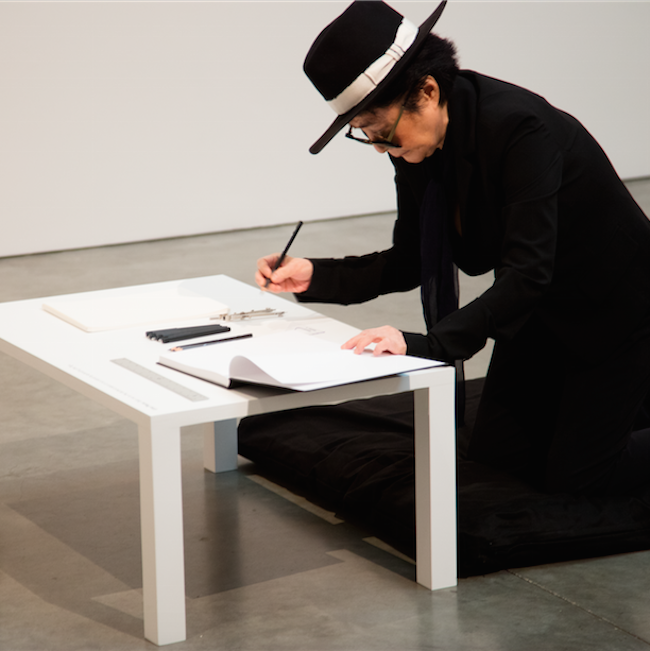Yoko Ono’s The Riverbed (New York City, December 11, 2015 — January 29, 2016) was a show that was so collaborative, Ono held it between two different New York galleries, Galerie Lelong and Andrea Rosen Gallery. It blended contemporary ceramics with meditative practices. In each location Ono installed works that demanded participation from the visitors. This was communicated in simple directives from the artist that read like short poems.
Above image: Yoko Ono at “The Riverbed,” 2015-16 at Galerie Lelong and Andrea Rosen Gallery. Photographs courtesy of the galleries and the artist.
“THE RIVERBED is over the river in-between life and death.
Stone Piece: Choose a Stone and hold it until all your anger and sadness have been let go.
Line Piece: Take me to the farthest place in our planet by extending the line.
Mend Piece: Mend with wisdom mend with love. It will mend the earth at the same time.”

Ono has used participation as part of her work since the 1960s. The galleries state that The Riverbed breaks this down into the simplest of actions — holding a stone, drawing a line on paper, gluing a broken cup back together— that each call on the participant to reflect as they perform the act. Running under the hood of the exhibition was another piece of collaboration synchronicity: Ono and the two gallery leaders are females, another feature of Ono’s work.
Both galleries had a large pile of smooth river stones selected by Ono. These stones were inscribed with words such as “remember,” “dream,” or “wish” and the visitors received instructions to hold one of the stones in their lap, concentrating on the word and “letting go of their anger or fear.” In that way the pile of stones grows to represent the collective catharsis of everyone who visited the exhibition.


Another activity set a clean ream of paper in front of the participant, with the instruction to “draw a line to take you to the farthest place on our planet.” We’d like to see some more from this piece of the exhibition because the instruction it gives to people is both short while opening itself up to many interpretations. It would be interesting to see how strangers ran with that directive.


Click to see a larger image.
The final work was Mending Cup, an installation that shows in a number of Ono’s exhibitions. We recognized features of it from an earlier story we did about Ono’s mended tableware. The galleries state that Mending Cup reinforces the idea of healing as visitors used tape, string, and glue placed around the room to fix broken teacups. The act that the lone visitor makes is associated with the work everyone else did and by extension the work that is being done to mend broken things across the cosmos. Ono describes the activity:
“As you mend the cup, mending that is needed elsewhere in the Universe gets done as well. Be aware of it as you mend.”
We noticed that much of this activity took place around a table, something that recalls arts and crafts from elementary school or summer camp or youth programs. That’s another shared experience, drawing people out of their isolation into a community that could span infinity if it had to. It’s impressive that Ono packed so much into a couple of minimal white rooms using very few words to set her audience on their course.
In the last ten years, Yoko Ono’s pioneering role in the international development of Conceptual art, experimental film, and performance art has begun to be more fully acknowledged, according to the galleries. In summer 2015, the Museum of Modern Art, New York, presented Yoko Ono: One Woman Show, 1961-71, which reinforced her influence as one of the most important cultural change agents. Currently on view at the Museum of Contemporary Art, Tokyo is Yoko Ono from my Window, also on view at the Faurschou Foundation, Beijing is Yoko Ono: Golden Ladders. In 2016 Yoko Ono: Lumiere will open at the Museum of Contemporary Art, Lyon. Galerie Lelong has previously collaborated with Yoko Ono and Studio One on two previous exhibitions: Touch Me (2008) and UNCURSED (2011). Andrea Rosen Gallery recently included Ono’s Sky TV (1966) in the exhibition The Thing and The Thing In Itself (2014) curated by Robert Hobbs.
Bill Rodgers is the Managing Editor of cfile.daily.
Do you know of any other ways to combine contemporary ceramics and community? Let us know in the comments.


Images from Yoko Ono, “The Riverbed,” 2015-16 at Galerie Lelong and Andrea Rosen Gallery. Photographs courtesy of the galleries and the artist.



I saw Yoko Ono’s 1971 show, “this is not here…” at the Everson, an important museum in our ceramic history. The exhibition catalogue took the form of a collage in the shape of a newspaper. I still have it. It opened my mind to conceptual art. 加油Yoko. Inspiring unwavering perseverance.
Yoko’s interaction with ceramics is fascinating.